Columbia River
In her new photobook, Justine Kurland presents an alternative narrative of contemporary American life drawn from road trips taken across the US between the years 2005 and 2010 with her young child Casper. Featuring a sequence of arresting large-format photographs, This Train re-appraises a set of paradigms which retain a tenacious grip on contemporary American life: the nuclear family, the open road, the violence of expansion and the intractable force of the land itself. This Train by Justine Kurland is published by MACK
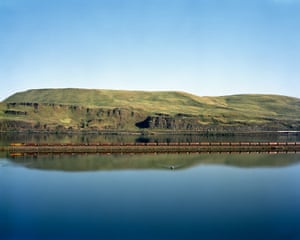
Hippy Stir Fry, 2008
The book features two interwoven narratives. The first revolves around photographs of Kurland’s child and herself, disentangled from the images of roads, trains, infrastructure and fellow travellers that Kurland was also making at the same time. The other thread involves Kurland’s photographs of the railroads which traverse the American landscape. Deconstructing the familiar mythology of the railway as a pioneering symbol of modernity, these images observe the reality of the ways these routes carve and stain the landscape, leaving behind barren strips of sun-stained asphalt

Days Inn, 2007
Revisiting these photographs, Kurland suggests a reading of them as an anti-history of family and travel, upending the conventional family album to tell a story of queer motherhood and image-making in step with Kurland’s maternal line, for whom crossing the American landscape was a matter of dire necessity
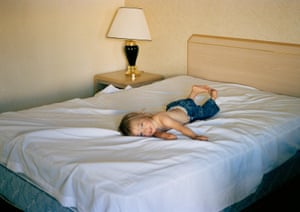
Wind Blowing Through Columbia Gorge, 2008
Justine Kurland: ‘I had spent over a decade making photographs on road trips before my son Casper was born. I continued on the road for another decade thereafter. From age six months to six years old we lived out of a van for eight months of the year, and then every summer until he turned 11. I photographed many different subjects during that time, but when Casper’s obsessional attention turned to trains, I decided to photograph them’
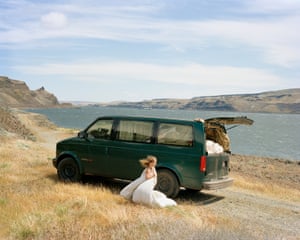
Empty Flat Cars, 2007
‘I would set my 4x5 camera up along the tracks, often along designated scenic views posted online by rail fans because of ingenious innovations looping trains over mountain passes or tunnelling through the rock. And then we would wait, sometimes all day, for a train to come through’
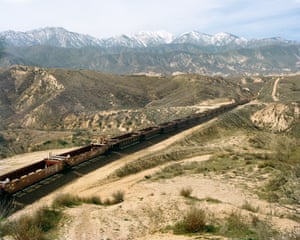
Violin and Legos, 2010
‘I made photographs of Casper while we waited for trains or of us together at campsites. This ritual bonded us. Friends warned me against photographing my child, and I knew it was a risky business. My teacher Laurie Simmons, a renowned photographer in her own right, had spoken to our class about her generation where artists had to pretend they hadn’t had children to avoid the misogynistic cliche. Things have changed but not that much, motherhood as a female experience that is constituted by acts of nurture and care still make most people feel uncomfortable’
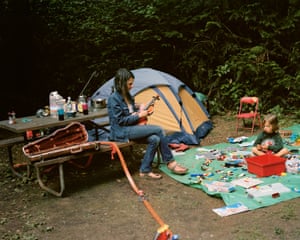
California Wild Flowers, 2009
‘Family albums usually look the same: holiday dinners and birthday parties, children positioned in front of prized roses, or domestic settings that project class and stability through guises of normalcy drawn from scenes in television sitcoms. Where are the family albums of a queer single mother living on the road with her child? The only one I’ve ever seen is from my own childhood. My mother supported me and my siblings by travelling up and down the east coast to make a living selling crafts at Renaissance fairs’
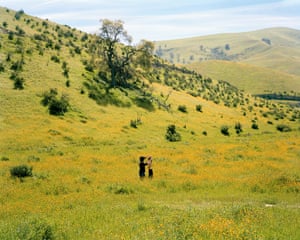
Georgetown Loop, 2009
‘My photographs exist within and against traditions of road trip photography but I understood how to do this not because of Robert Frank, but because I had inherited certain types of knowledge from my mother: how to get by in a nomadic mode, how to build out a liveable van and how to raise children as an extension of a family business. These pictures are dear to me not simply because it’s me and my son, but because it asserts the legitimacy of non-normative family life and the possibility of freedom from those patriarchal constructs’

Byers Canyon Coal Cars, 2008
‘In photographing the trains I inadvertently captured the shadow side of the American west. The trains roll over unceded territories and sites of the genocide of indigenous people. Asian-American immigrants built the railroad but many died from unsafe working conditions, from disease and lack of medical care, and suicide brought on by the despair of their situation. The US government enacted The Chinese Exclusion act of 1882, which blocked them from citizenship. These facts were hard to reconcile with my child’s unfettered love of trains’
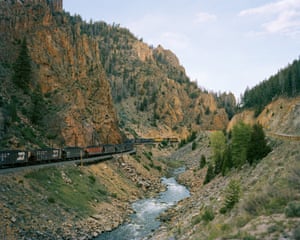
Go Dog Go, 2010
‘Casper learned to read from signs that lined the highway. Days Inn was a particular favourite maybe because the logo of a sun resting on the horizon of letters situated language into the landscape he was so accustomed to. In this picture he’s reading aloud from Go, Dog, Go, a book he favoured. We are naked because it was unbearably hot but also because our apartness from the world allowed us to embrace our brute animal existence’
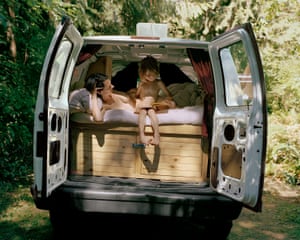
Door Sill Train Track, 2008
‘Casper thought living in a van was normal – that other mothers loaded sheet film at highway rest stops, that other kids stacked rocks while their parents composed scenes. Often people thought we were homeless and offered us food or money. Parents would pull their children away from us in playgrounds. Casper was the constant focus of my attention and I struggled to find space to work’
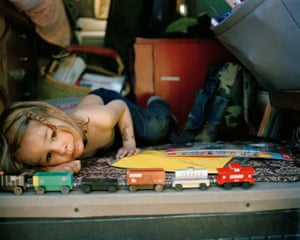
Counting Boxcars in the Cajon Pass, 2010
‘So much has happened between now and then. Casper’s transition off the road and back to a life where he could integrate with other children was not easy. My own ambivalence, despite the intensity of my love, in parenting did not help. Looking back at these pictures I see his resilience and the many ways he contributed to the work, pictures he gave to me or that were negotiated when he wasn’t content to sit still for the camera. The result is a love letter to him, a souvenir of a boyhood long since lapsed. I am grateful for these times together’
